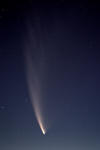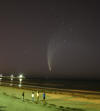

January 17, 2007.
Situated only 13 degrees from the Sun.
Left: 9:16pm ACDT, Canon 300D, 4/10 second exposure,
ISO 400, fl 300mm cropped
Right: 9:18pm ACDT, canon 300D, 13/10 second exposure,
ISO 400, fl 115mm
Comet C/2006 P1 McNaught
THE GREAT DAYLIGHT COMET OF 2007
Closest to Sun: 2007 Jan 12 at 0.17AU
Closest to Earth: 2007 Jan 15 at 0.82AU
Peak brightness: magnitude -5 on January 14, 2007.


January 17, 2007.
Situated only 13 degrees from the Sun.
Left: 9:16pm ACDT, Canon 300D, 4/10 second exposure,
ISO 400, fl 300mm cropped
Right:
9:18pm ACDT, canon 300D, 13/10 second exposure,
ISO 400, fl 115mm



January 22, 2007.
Location: Henley Beach, Suburb of Adelaide
Left: Canon 300D, ISO 800, 90mm lens, 20 seconds.
Middle: Canon 300D, ISO 800, 18mm lens cropped, 30 seconds.
Right: Canon 300D, ISO 800, 18mm lens, 30 seconds.


January 23, 2007.
Location: near Myponga, South Australia
Left: Canon 300D, ISO 800, 18mm lens cropped, 34 seconds.
Right: Canon 300D. ISO 1600, 18mm lens, 80 seconds.
Note the difference a dark sky makes when compared to the January 22 photos.
The tail striations stretch well beyond Fomalhaut, over 30 degrees from the
comet.



January 24, 2007.
Location: Stockport observatory, South Australia
Left: Canon 300D, ISO 800, 18mm lens, 60 seconds.
Middle: Canon 300D, ISO 800, 18mm lens cropped, 60 seconds.
Right: Canon 300D. ISO 800, 18mm lens, 100 seconds.

January 25, 2007.
Location: Grange beach, suburb of Adelaide, South Australia
Canon 300D, ISO 800, 18mm lens cropped, 60 seconds.
Increasing moonlight is becoming a hindrance to comet viewing.



January 29, 2007.
Location: Penwortham, Clare Valley, South Australia.
Justin Tilbrook's observatory.
Canon 300D, ISO 800, 18mm lens cropped, 30 seconds.

February 4, 2007.
Location: Melbourne, Victoria. Magnitude 3.8
Canon 300D, ISO 800, 40mm focal length, 3x30 seconds cropped.

February 9, 2007.
Location: Two Wells, South Australia. Magnitude 4.3
Canon 300D, ISO 1600, 18mm focal length, 3x30 seconds cropped.

April 17, 2007.
2x3 minute exposure Canon 300D + 300mm zoom lens.

May 10, 2007.
10x10 sec, C11 SCT at f/3 + MX7c ccd.
Discovery
Robert McNaught, a professional astronomer conducting the Siding Spring
survey (near Coonabarabran NSW) reported his discovery of a new comet on Aug
7, 2006. This was Robertís 31st find. The magnitude 17 comet was
then situated 3 astronomical units (AU) from the Sun. This distance rapidly
reduced to 0.17AU from the Sun on January 12, 2007 where the comet appeared brightest.
Development
C/2006 P1 was within 30 degrees of the Sun since early November 2006 but
was still followed by amateur observers equipped with CCD cameras. By early
January 2007, visual observations from the northern hemisphere were reported as
the comet rapidly brightened in the twilight sky.
The comet arrived in the field of view of the orbiting SOHO C3 coronagraph on January 12.
On Jan 15, the comet was closest to the earth at a distance of 0.82AU, appearing only 7 degrees away from the Sun and shining at magnitude -3.
By the evening of January 18, the comet had moved sufficiently away from the Sun (15 degrees elongation) and appeared very low in the western evening sky after sunset in the constellation of Microscopium. It appeared as bright as magnitude -1.
On January 24, the comet moved into Indus but was still only 27 degrees away from the Sun and a mere 5 degrees above the horizon at the end of astronomical twilight from 35S latitude. It then shone at magnitude 1. Unfortunately, moonlight began to interfere with dark sky viewing until after the full moon of Feb 2.
By February 9, the comet had faded to magnitude 4.3.
Further information can be found at Robert McNaughts
website:
http://msowww.anu.edu.au/~rmn/C2006P1.htm